
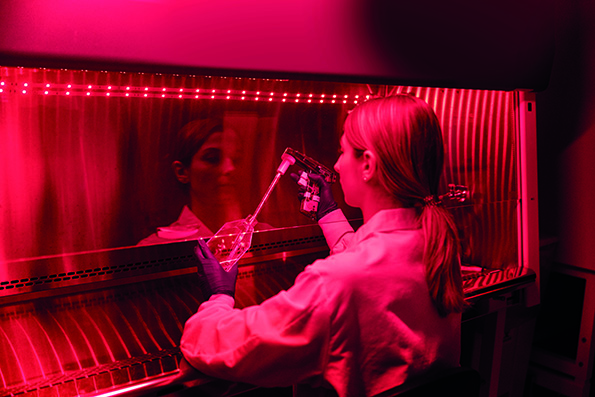
Ones to Watch: Fast Food
Could specialization hold the key to getting cultivated meat onto dinner plates quicker? Or are differentiators simply less important than solid science, productive partnerships, and adequate funding? Addressing both questions, Louise Davis grills the experts that are speeding up commercialization
If you ask nine people their opinions on the current state of play in the cultivated meat sector, you’ll receive nine very different responses. When canvassing our own nine experts here, it became clear that there are many different strands at play – including politics, science, the ever-present issue of funding, and, of course, the various issues relating to scale-up. These topics all determine how quickly (or not) cultivated meat will join the mass market.
What’s also becoming evident is that specialization – honing in one particular part of the overall system and becoming a true expert in solely that part – can play a massive role in hastening product rollout. By focusing on specific areas of expertise, researchers can accelerate development, overcome challenges, and bring delicious, viable products to commercialization.
Becoming a specialist rather than a jack-of-all-trades is paying dividends already. In a tough funding environment, investors are showing growing interest in the technology enablers rather than firms aiming to be one-stop-shops for cultivated meat products. Investors are drawn to these specialist solutions providers primarily because they offer the potential for accelerated development, cost reduction, improved product quality, scalability, risk mitigation, and synergies with other industries.
Three of the main key areas for specialization in cultivated meat are bioreactors and bioprocess, cell lines, and growth media. Here, we get input from a selection of companies across these sectors, all of which are aiming to be the best-of-breed in their individual disciplines.
It’s fascinating to watch an entire supply chain ecosystem developing in front of your eyes – we at PPTI are privileged to report on these developments with such world-changing potential. And the specialists featured here all put forward convincing evidence that helps counter the ongoing negative narrative on cultivated meat seen in some other outlets and parts of the political landscape that want to ban its sale.

Quest Meat
“At Quest, we are developing the building blocks for cultivated meat,” begins the company’s CEO, Ivan Wall. “We produce cell culture raw materials – cells and edible scaffolding that cells can attach and grow on in suspension. These ingredients can lower the costs of cultivated meat and also help it to cook and taste how meat should.”
Quest is far from alone in this market, so what’s unique about the firm’s approach to cell line development? “Starting with the highest-quality cells is critical for cultivated meat,” suggests Wall. “We have unique ways to boost the quality of the initial cell cultures, meaning we can increase quality throughout production for our customers.”

On the topic of specialization, Wall explains that Quest has focused on the cell culture part of production as this underpins manufacturability and cost of production. “That is our specialty,” he notes. “Between the team, we have decades of experience in growing adherent cells (similar to the muscles and fat that make meat) in industrial bioreactors, initially in developing manufacturing for stem cell therapies. We’ve translated that knowledge to cultivated meat and are developing cells, edible scaffolds and processes to manufacture. It’s very different to growing cells that are used to make biopharmaceuticals.”
The business model and path to commercialization is also very different to the pharma industry, which has budgets cultivated meat players can only dream of.
The current state of the industry is not a bad thing as it means those companies that can demonstrate strong scientific foundations to manufacture high quality at large scale will succeed
Discussing the industry itself, Wall believes that cultivated meat has definitely gone past the hype stage. “Early companies have realized the challenges and pitfalls of growing cells at scale to make something people want to eat,” he comments. “Many are now struggling and have failed to hit important development milestones.”
Only the strongest will survive
The lesson learned from the early pioneers, Wall concludes, is simply ‘don’t run before you can walk’ – there is no point attempting to go to market if your product isn’t up to scratch. “The early products weren’t even desirable meat – they’ve been made from fibroblasts that make up sinew and low-quality meat products, instead of the muscle and fat cells that make tasty and nutritious meat,” he says.
“The current state of the industry is not a bad thing as it means those companies that can demonstrate strong scientific foundations to manufacture high quality at large scale will succeed, and that will ensure consumers get access to food that is fit to eat. But we need to see better-informed investment approaches and move away from flattery with big financial projections and ‘differentiators’ that are not deliverable.”
Wall leads by example on this front. In January 2024, Quest announced a partnership with the University of Birmingham (UoB) in the UK that aims to accelerate the development of cultivated meat products by ensuring any potential pitfalls are tackled well before products
hit shelves. Detailing the partnership, Wall says, “With UoB we are looking at aspects of testing consistency and shelf life of products, as well as the environmental impacts and supply chain considerations of cultivated meat.”
Quest is also busy building its commercial cell banks and supporting customers with their bespoke needs. “We plan to establish new early access partnerships for our edible scaffolding and scaffold-cell solutions in early 2025,” Wall confirms.
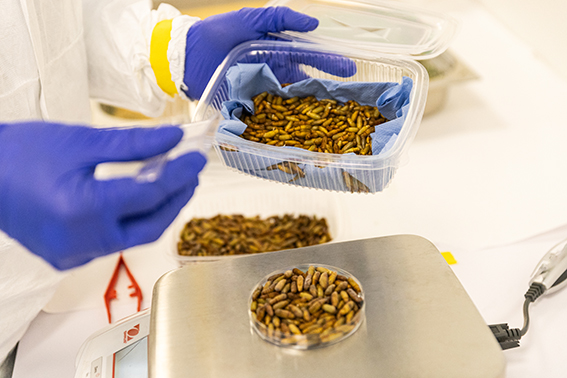
Cocoon Bioscience
When asked to describe his work in layman’s terms, Josh Robinson, CEO of growth media specialist, Cocoon Bioscience, makes his biotech role sound somewhat similar to that of a mixologist at a bar. “As many of your readers know, cultivated meat is meat grown from a small starting batch of cells – bovine, porcine, avian, etc – that grow up to mimic the taste, texture, and nutritional value of traditional meat,” he explains. “To grow these cells requires the right cocktail of input ingredients. One of the most important ingredients is a set of proteins that signal to the starting batch of cells to grow. These are known as growth factors and are something humans and animals produce in small quantities naturally.”

Providing some indication of scale, Robinson notes, “Only a pinch of growth factors is needed to grow cultivated meat – less than 1mg of growth factors for 1kg of meat – but they are some of the most complex and expensive components to make. Some are more accessible with traditional production methods than others. We make the most difficult and unavailable growth factors, with a performance and a price point that work for the cultivated meat industry at scale.”
Tackling this challenging work involves a unique approach, and Robinson describes his technology as both novel and somewhat unorthodox. “Instead of producing the growth factors by the traditional means – microbial fermentation with a single-cell bacteria such as E. coli – we instead harness insects in their chrysalis stage and redirect them to make the target growth factors using a virus that is specific to these insects (and harmless for humans and mammals),” he explains. “These insects are highly productive in making many of the required growth factors and can handle many of the post-translational modifications and folding steps that trip up other, more traditional technologies for making proteins.”
Unorthodox as it may be, the approach is proving incredibly successful. Cocoon has recently completed scaling its technology to a commercial manufacturing facility in Bilbao, Spain, with more than 4,000m2 of space, where it can produce growth factors with the scale, performance, quality, and price point needed for its partners. “Building and automating this process at scale required detailed planning and innovative solution development by our technical and engineering teams,” Robinson comments. “It is no small feat to engineer a system to synchronize the life cycles of thousands and thousands of insects to within hours.”
Link in the chain
Focusing on one system forms the heart of Cocoon’s ethos, and Robinson is very clear on this. “Our goal is not to become more vertically integrated – for instance, I highly doubt you will ever see Cocoon launching our own cultivated meat product,” he says. “Instead, we want to lean into the unique advantages of our protein expression platform to solve the most impactful bottlenecks that we see ourselves offering a solution for. Right now, that is growth factors for cultivated meat, as well as certain specialty enzymes for healthcare. We make recombinant proteins – growth factors, enzymes, etc – and we want to continually improve how we make them in terms of quality, timing, performance, and robustness. This requires focus on our specialized area, and any movement toward other areas that aren’t our core focus would be a distraction.”
When asked for his thoughts on the industry as a whole, Robinson observes that cultivated meat seems to be well along in the journey of the standard hype cycle. “Ten years ago, it was crazy; five years ago, it seemed possible and on the doorstep; then over the past five years, there has been a ton of innovation, advancement in scaling, better understanding on the regulatory and commercial side to allow for a successful launch, as well as startup/corporate partnerships with leaders in the food and meat industry today,” he says. “Basically these companies at the vanguard have been doing all the hard work in the background to make this a sustainable industry (in more ways than one), while the concept of cultivated meat has gone through the ringer of the press and become politicized, at least in the USA.”
Only a pinch of growth factors is needed to grow cultivated meat, but they are some of the most complex and expensive components to make
Looking ahead, he adds, “It seems as if cultivated meat as an industry has survived the downturn of the hype cycle and is poised to launch in the near future and we are thrilled to be part of the enabling technologies emerging to meet the needs of the next generation of meat.”
For Cocoon itself, the current focus is on continuing to develop new growth factors that are needed by its partners – which includes a range of species. “We are working on a few growth factors for more ‘exotic’ species that are really exciting to tackle,” he says. “They just aren’t out there today for any producer that wants to move beyond cultivated pork or beef.”

Cellular Agriculture
From the off, the team of innovators behind the UK firm, Cellular Agriculture, had a strong vision as to where the business sits within the broader industry. “We are developing technology to enable food manufacturers to cultivate meat, seafood and dairy,” explains Illtud Dunsford, CEO & Co-Founder. “Our technology supports the growth of cells in a controlled environment using bioreactors, which function like the body’s natural system. This method allows the creation of sustainable, environmentally friendly food while reducing the impact on the planet.”

Acting as an enabling cog in a bigger wheel reflects Dunsford and his team’s view that specialization is crucial in cell-cultivated protein, as it allows experts to focus on refining specific aspects of the process, or scaling technology. “By narrowing their focus, researchers can tackle challenges more effectively, drive innovation faster, and ultimately accelerate the path to commercial viability,” he says. “This collaborative ecosystem – where each player excels in their niche – brings cultivated protein closer to being a sustainable and scalable solution.”
So, how does Cellular Agriculture tackle its own area of specialization? “Our specialization lies in bioreactor innovation, which is the foundation for successful large-scale production in the cultivated meat industry,” Dunsford says. “By developing scalable, cell-agnostic bioreactors, we enable other players to focus on their expertise, such as cell lines or media development. This approach ensures that while we master bioprocess efficiency, the entire ecosystem advances more rapidly towards commercialization. Ultimately, our future customers will be large-scale food manufacturers who will be able to choose their technology and input to deliver scaled production.”
Cellular Agriculture was an early bioreactor pioneer. It was founded in 2016 as the first UK startup in the cultivated protein space. In 2018, InnovateUK funding supported the development of a proof-of-concept bioreactor system, a version of which was displayed at Nemo Science Museum in Amsterdam through the summer of 2019. This was the first-ever public demonstration of enabling technology for the nascent cultivated protein industry. Fast-forward to today, and the bioreactor is not quite fully commercialized, but Dunsford reports rapid progress and an obvious differentiator present from the start. “Our bioreactor is unique due to its hollow fiber membrane technology, which replicates a body’s vascular system, producing more cells in a smaller footprint. We’re already working on delivering a first system to Campden BRI, but we aim to expand our user base within the next 18 months.”
Meat market
Alongside enormous recent technical progress such as this, there has been a fair amount of negative press surrounding cultivated meat, and Dunsford acknowledges that the cultivated protein industry is experiencing both technical breakthroughs and “the growing pains that are normal for a nascent industry”. But, he counters, “Regulatory breakthroughs are significant. Our company was founded in a time when few product demonstrations had even been delivered. The thought of experiencing cultivated meat in a restaurant at that time was an ambition, rather than reality.”
This collaborative ecosystem, where each player excels in their niche, brings cultivated protein closer to being a sustainable and scalable solution
Dunsford points out that this progress also brings its own expectations. “Market access does not equate to wide-scale adoption. Despite political challenges and a slowing investment landscape, this market access provides an opportunity for technology to advance rapidly. We believe the future holds widespread adoption as sustainability and food security become critical global priorities.”
Closer to home, Dunsford’s own priorities now revolve around getting his technology out there. “Currently, we are focused on scaling our bioreactor platform and preparing for its market debut,” he reveals. “We’re also exploring new partnerships to expand our global reach and introduce our technology to diverse markets.”
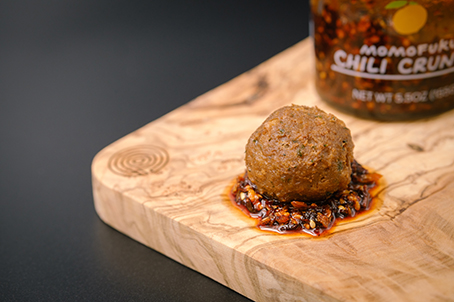
Prolific Machines
California-based Prolific Machines operates in an interesting technical area involving the intersection of light, AI, and hardware. “We harness light to produce everyday essentials more efficiently – from cultivated meat and nutritional proteins to life-saving drugs and novel biosolutions,” says Deniz Kent, CEO & Co-Founder. “We use light as a signal to control cellular behavior with unprecedented precision and instantly instruct cells on what to do and where and when to do it. Our process leverages optogenetics technology and creates significant cost, speed, yield, and quality advantages.”

Detailing this approach, Kent explains that living organisms have the ability to sense light because of light-sensitive proteins (LSP). “These naturally occurring proteins are found everywhere – from plants and bacteria to human retinas – and exist to detect and respond to light. They can do this very quickly to cause action in cells within seconds. By attaching LSPs to proteins that you want to control within the cell, Prolific Machines makes it possible to precisely control subcellular biology using light. When met with light, which acts like a signal, these LSPs can precisely control cells across key functions.”
Light fantastic
According to Kent, Prolific Machines unlocks dynamic control by pulsating light in specific patterns, intensities, and wavelengths to activate cellular functions when and where it matters most, which he describes as a gamechanger for biotechnology. “Photomolecular biology is the use of light and AI to precisely control and optimize cellular behavior to more efficiently produce superior bioproduct solutions across wide-ranging applications, including cultivated meat and nutritional proteins,” he says.
Scientific methodology aside, Kent says there’s a genuine business case for his approach simply as existing methods used to make bioproducts are limited to imprecise, inefficient, and expensive control levers, such as temperature, chemicals, and proteins, to indirectly control cells. “Our platform brings together safe and effective tools – light, hardware, and AI – to unlock unparalleled control and precision,” he says proudly.
When it comes to cultivated meat production, one of the key benefits of Prolific’s photomolecular platform is cost efficiency, due to its use of light, which is the cheapest possible input into biology. “Our process also removes the need for costly growth factors, which are the most expensive part of the cultivated meat process,” Kent explains. “It presents the cultivated meat industry with an unprecedented solution to tackle cost and scale challenges.”
Our process removes the need for costly growth factors, which are the most expensive part of the cultivated meat process
In terms of how it achieves that bold claim, Kent reveals, “Our technology provides remarkable control across the space and time axes. This allows for yield advantages along with specific patterning to produce entire cuts of meat. It also allows us to differentiate cells from one type to another with incredible precision, allowing for the creation of structured meat products.”
To translate this into real-world benefits, Kent says that Prolific Machines is in the process of finalizing partnerships with players across cultivated meat, nutritional proteins, and pharmaceuticals, “where we’ll leverage our platform to help bring better products to market”. And the tech expert has no doubts that these efforts will pay dividends. “We remain bullish and excited about the cultivated meat industry. We strongly believe our technology will help reduce cost and scale barriers and look forward to working with cultivated meat companies to accelerate their production processes.”

Opo Bio
When describing her work to people who aren’t experts in cultivated meat, Dr Olivia Ogilvie, the CEO of New Zealand-based Opo Bio, uses an agricultural metaphor to simplify the concept. “We develop cell lines – these are analogous to the seeds. They are the biological starting point for cultivated meat and biomanufacturing. If you don’t have good seeds, it’s hard to produce products (be it cultivated meat, carrots, or tomatoes) at scale,” she explains.

So, how exactly will Opo Bio’s ‘seeds’ accelerate the commercialization of cultivated meat? “Our focus is to develop the best cell lines, enabling other companies from the cell up,” Ogilvie continues. “We aim to enable other companies to succeed at scale. We believe that a focused approach is key to maturing the industry and overcoming the technical challenges currently faced throughout the supply chain.”
Special delivery
Ogilvie uses the term ‘focused’ but it sounds very much like she’s advocating for the merits of specialization. Is that correct? “Yes – this is precisely our goal! We believe that specialization across the supply chain can lead to larger and/or faster innovations within each technical category. When combined by end-product manufacturing companies, these innovations will compound and allow products to reach commercialization faster, with less capital investment,” Ogilvie states.
That latter point could prove to be invaluable, given the current funding landscape, something Ogilvie rightly acknowledges. “It’s tough out there! There’s been a big shift in investor sentiment over the past two years – we have only seen the early effects of this trickling through to companies.”
In such a climate, startups such as Opo Bio face heightened pressure, but Ogilvie remains confident. With the right technical approach, she believes the obstacles can be overcome. “At Opo, we’ve always been steadfast on the fact that cultivated meat is deep-tech, not FMCG like other alt protein categories. The commercialization timelines for deep tech are long and associated with both technical and market risk. Many companies have undersold the technical challenges and timeline in bringing products to market, and this has backfired in some instances. This is why our approach has always been different, with a focus on developing the enabling biotechnology for industry.”
Our focus is to develop the best cell lines for the industry, enabling other companies from the cell up
So far, Ogilvie’s targeted approach is proving attractive to investors. Opo Bio was founded in July 2022, and by November of the same year, it announced a NZ$1.5 million Seed capital round led by Matū Karihi, syndicated with The University of Auckland Inventors’ Fund, Booster Innovation Fund, and angel investors.
This is no mean feat for a Kiwi startup in a nascent industry that receives a constant backlash for its perceived controversies and faces lobbying efforts designed to stamp it out before it fully gets going. Against this rather bleak-sounding background, Ogilvie remains steadfastly optimistic. She points out that despite negative press and less available funding, we should absolutely celebrate the wins we’ve seen so far. “Although the industry is only around 10 years old, we’ve already witnessed many significant advancements towards commercialization – and the best is yet to come,” she observes, emphasizing the steady progress being made in this groundbreaking field.
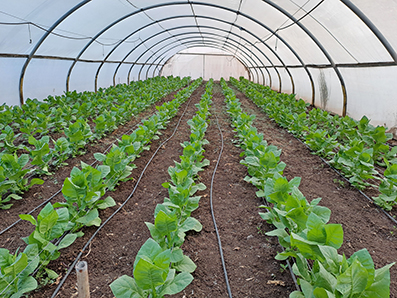
BioBetter
As CEO of Israeli firm, BioBetter, Amit Yaari is spearheading efforts to produce growth factors from a very novel source. “Growth factors are like nutrients for the cells, and without them, cultivated meat wouldn’t be possible, he says. “Traditionally, these ingredients are very expensive and hard to make in large quantities. We’ve developed a way to produce these growth factors using tobacco plants, which allows us to produce them at a much lower cost and in larger quantities. This makes the production of cultivated meat more affordable and sustainable, helping to bring this new type of meat to market.”
Expanding on this, Yaari adds, “Our approach is unique because we harness the power of molecular farming, using tobacco plants as natural bioreactors to produce growth factors, which are crucial for the cultivated meat process. Molecular farming is a sustainable and cost-effective method that allows for the large-scale production of complex proteins. By growing these proteins in plants, we significantly reduce production costs and environmental impact compared to traditional methods such as fermentation. Tobacco plants, in particular, offer advantages such as fast growth rates, high biomass yield, and the ability to be cultivated in non-food crop areas, minimizing the risk of cross-contamination with food crops. This innovative approach enables us to produce high-quality growth factors at a fraction of the cost, making cultivated meat more commercially viable.”

Yaari says that BioBetter has adopted a ‘pick-and-shovel’ strategy, “focused on providing the essential tools – growth factors – that cultivated meat companies need to succeed”. By specializing in this narrow sector of molecular farming – particularly leveraging the advantages of tobacco as a non-food crop – BioBetter can maximize its comparative advantage. “Tobacco’s unique properties allow us to produce these critical ingredients more efficiently and cost-effectively than other methods,” Yaari continues. “Our approach is to take some of the tech-development load off the shoulders of cultivated meat companies, enabling them to focus on what they do best while we supply them with the high-quality, affordable growth factors they need. I believe that by specializing and working in parallel, we can significantly speed up the overall development of the cultivated meat industry, making it possible for this innovative technology to reach commercialization faster.”
Beyond the hype
Similar to others in the marketplace, Yaari has noticed a definite pattern in the path to commercialization. “Generally speaking, the market for cultivated meat is following the Gartner Hype Cycle,” he says. “We’ve recently passed the ‘Trough of Disillusionment,’ where initial hype gives way to a period of doubt and criticism, and we are now entering the ‘Slope of Enlightenment,’ he details. “This is where the market is beginning to experience slow but steady growth as the technology matures and more practical applications emerge.”
Yaari and his team at BioBetter firmly believe that the transition to cultivated meat is inevitable, even though the pace is slower than initially anticipated. “Radical technological changes, such as the adoption of electricity, which took over 50 years despite its overwhelming advantages, naturally take time,” he comments. “The current phase is crucial for refining the technology, gaining regulatory approvals, and building consumer acceptance. We are optimistic that cultivated meat will gradually move toward widespread adoption, similar to other groundbreaking technologies throughout history.”
We harness the power of molecular farming, using tobacco plants as natural bioreactors to produce growth factors
BioBetter’s own efforts to nudge the sector towards widespread adoption involve continuously working on expanding its portfolio of growth factors to meet the diverse needs of the cultivated meat industry. “Our immediate focus is on scaling up our production capabilities to ensure we can meet the growing demand from our partners in the industry,” Yaari says. “One of our key innovations is the development of growth factors that are attached to something called a Cellulose Binding Domain (CBD). This CBD acts as a stabilizer, significantly enhancing the stability of the growth factors, improving their activity, and prolonging their half-life. This advancement allows cultivated meat producers to use much lower concentrations of growth factors, which reduces costs and improves efficiency.”
Yaari also hints at tangible progress elsewhere. “We are exploring partnerships with other innovators in the field to integrate these stabilized-soluble growth factors into new cultivated meat products,” he reveals. “Although we can’t reveal too much at this stage, we are excited about several upcoming projects that will further solidify our position as a key supplier in the cultivated meat ecosystem.”
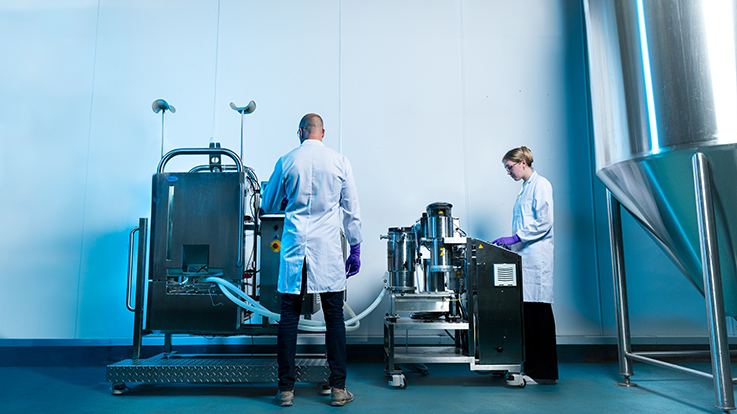
Extracellular
The UK firm, Extracellular, is a perfect example of a company with an empowering role to play in commercializing cultivated meat products faster. In fact, its entire ethos is to act as an enabler. “We provide expert contract research and contract manufacturing services to the leading companies in the cultivated meat industry,” explains Nico Hutton, Chief Commercial Officer.
So, how can Extracellular’s services assist customers in accelerating their path to commercialization? “We help with certain pain points of their R&D journey, whether they’re having issues developing their cell line, media or manufacturing process,” Hutton says. “We provide specialty expertise and equipment to expediate their journey and get them to market as efficiently as possible.”

In a concrete example of the impact bringing Extracellular onboard can have for startups, Hutton notes, “We also help customers scale their technologies from the lab scale to commercial scale, negating the need for them to build pilot-scale facilities that they won’t need in three to four years’ time, and leveraging experts in scaleup biomanufacturing techniques.”
Arrested development
It’s obvious that Extracellular has a strong belief in the value of partnerships to tackle some of the hurdles on the path to commercialization. “For cultivated meat to achieve its environmental and economic potential, the industry needs to work together to break through the barriers that exist today. For this, we need a functioning global ecosystem, where players specialize in certain activities, and fill the gaps in capabilities of other players,” feels Hutton.
Hutton believes that specialization will play a key role in developing that functioning ecosystem. “We understand that getting a cultivated meat product to market is tough, and there are many aspects of the technology a company must develop excellently,” he says. “But doing everything excellently is hard, and instead of every company going through the same challenge, they should lean on the expertise that has been through these challenges previously.
“This is why we specialize only in certain areas where we have an excellent capability base – such as suspension adaptation of cell lines, optimizing media for better performance and cost, or developing efficient bioprocesses and scaling these effectively,” Hutton adds. “This is while our customers focus on developing an effective cell-line, getting their products regulatory approved, and developing excellent products.”
And those customers certainly are reaping the benefits of Extracellular’s expertise in their defined field. Among many success stories, including “running perfusion techniques at a variety of scales up to 200 liters, some of which have achieved cell-densities of 100g/liter and above, and scaling processes to >2,000 liters”, Hutton reports a hugely successful project with Merck to scale its species-specific media formulation. “We were able to scale Merck’s technology to 200 liters in just five months, reducing the company’s developing costs and timeframes by >70%,” he details.
Instead of every company going through the same challenge, they should lean on the expertise that has been through these challenges previously
Hutton regards the media storm around cultivated meat as an expected part of the commercialization cycle. “Our view is that this is just natural aversion to technology and societal change, which has happened with many other technologies in the past, from electric vehicles to solar panels to wind farms,” he notes. “Agriculture workers feel under stress already with environmental and cost pressures, and a new game-changing technology provides even more pressure. So, the aversion is understandable, but it doesn’t mean that this should stand in the way of positive global change.”
Ultimately, Hutton suggests, if his functioning global ecosystem comes to fruition, the end products will speak for themselves. “Getting tasty, healthy, and safe products to market will go a long way to placating any naysayers and provide our industry a lot more support. Just like Chat-GPT did for showcasing the power of AI, if people can experience the wonders of cultivated meat, we will have a lot more societal and governmental support.”
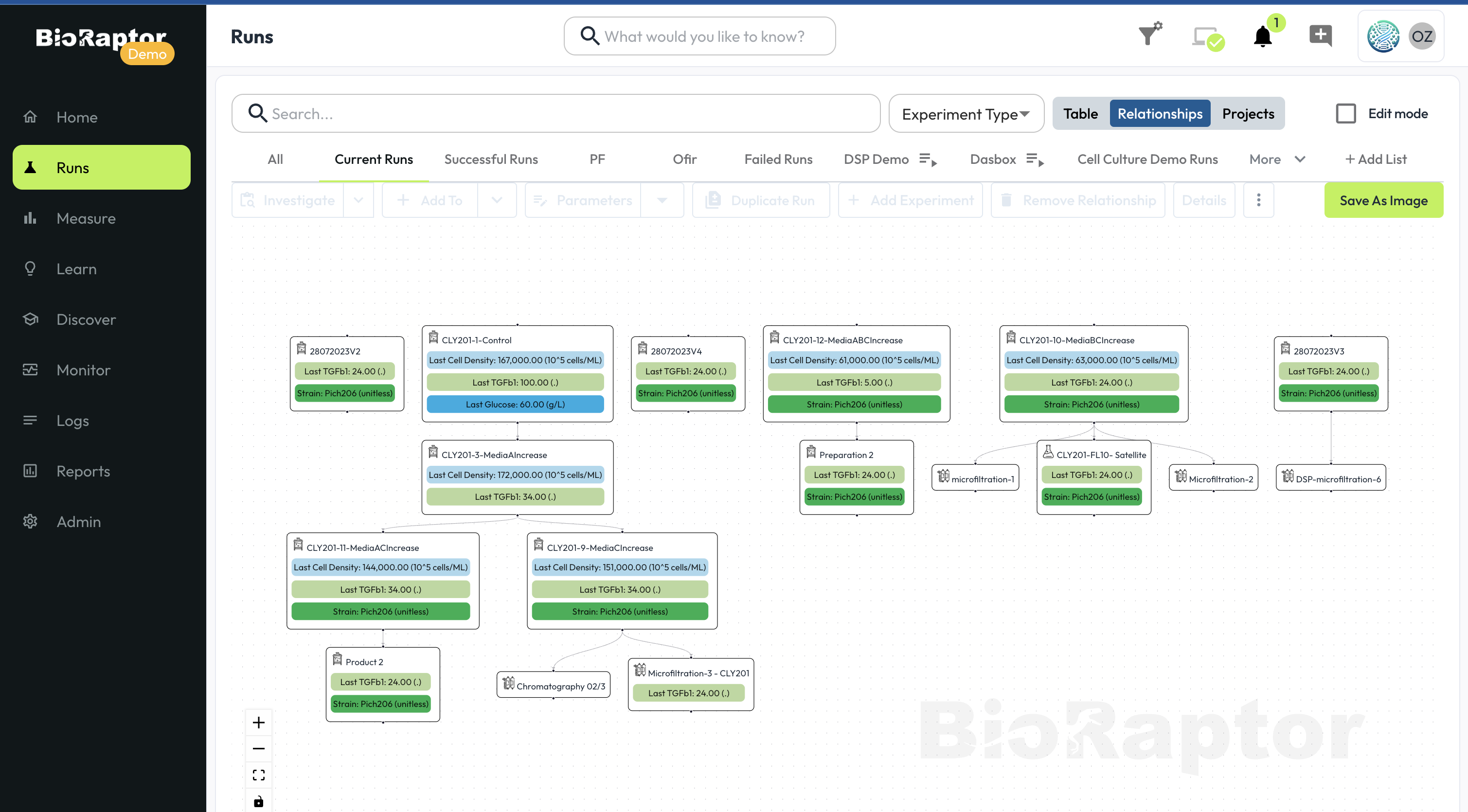
BioRaptor
As CEO of the dynamically named BioRaptor, Ori Zakin spends a lot of time thinking about bioprocessing – the science of growing organisms in the lab to produce valuable products. “In the field of cultivated meat, this means growing muscle and fat cells to form meat-like structures,” he explains. “The development of bioprocesses mirrors the journey that humans, domesticated animals, and even crops have gone through – optimizing growth conditions and improving genetics through selection.” But there’s one key difference. “It took 10,000 years to domesticate cows, but in the lab, we need to achieve similar breakthroughs with cells for cultivated meat in just months or years,” Zakin points out.

So, how can BioRaptor help achieve such breakthroughs? “We provide a software solution that ties together advances in machine learning and software engineering with the latest progress in biology, accelerating that process for companies developing cultivated meat, as well as those working in additional bioprocess domains such as precision fermentation and advanced gene and cell therapies,” explains Zakin.
Software companies are not exactly uncommon in the biotech sector but Zakin notes that BioRaptor’s approach to data is what sets it apart from other players. “We gather all the data generated in the lab or production site and use that to generate actionable biological insights,” he says. “A key difference is that we don’t collect that data for a specific hypothesis; rather, we collect all the unbiased raw data. That allows us to learn across experiments and also suggest new hypotheses based on the data that’s already been collected.”
What this translates to for cultivated meat players is that it frees them up to concentrate on what they do best. “We enable our customers to focus on their specialization, whether it relates to the cell line, media, process, or even advanced novel hardware solutions,” Zakin details. “Our own specialization is software engineering and advanced data science tailored for bioprocess. So rather than using generic software for statistical analysis or generic data platforms, we built a solution that is best suited for bioprocess development and optimization.”
Zakin reports that it’s a constantly evolving solution, too. “The team is currently working on different aspects of the product, ranging from the ability to onboard a company within days versus weeks, to providing bioreactor simulations. We are constantly rolling out features in a continuous development cycle, so our customers get valuable new features every few weeks.”
It took 10,000 years to domesticate cows: but in the lab, we need to achieve similar breakthroughs in months
Discussing further evolution, he hints that there are interesting partnership announcements on the horizon with firms “whose names need no introduction”.
Better, faster, stronger
Commenting on the cultivated meat industry overall, Zakin feels that despite naysayers and negative media coverage, things are looking pretty good right now. “Although the initial hype may have died down, the progress has not. We’re seeing companies that are leaner, more focused, and standing on the shoulders of the first movers, making steady advancements.”
Zakin describes such progress as a “significant revolution”, but it’s not one that happens overnight, he acknowledges. “We’re witnessing its gradual evolution, and the market reflects that,” he feels. “There are advanced players proving they’re on the right track, and the industry as a whole is moving forward. However, I also believe there’s room for collaboration. The real competition isn’t between the various companies in this space – it’s the industry versus the traditional entrenched industries. For the cultivated meat and broader bioprocessing industries to truly disrupt and replace conventional industry, it’s essential that multiple players succeed in bringing quality, affordable products to market.”

Triplebar
“Our platform is designed to solve one of the biggest challenges in biotech broadly, and cultivated meat in particular, which is the speed and certainty of engineering cells to achieve valuable performance outcomes” begins Shawn Manchester, COO at California-headquartered biotech firm, Triplebar. “For cultivated meat, this means we optimize cell lines with the right genome sequence to deliver necessary commercial performance outcomes. We are also currently applying our platform to precision fermentation, biologic drug discovery, and biologic manufacturing. Our mission is to create products that nourish, heal, and sustain people and the planet.”
Manchester describes the company’s work as harnessing the power of biology to ‘run evolution at hyperspeed’. Explaining, he says: “Our Hyper-Throughput platform can measure the effect of billions of mutations. We oversample the genome every day to quickly find improvements in cell line performance. We do this exponentially faster than conventional methods of high-throughput screening. In alternative proteins, speed is the difference between great products getting to market and failing to leave development. We partner B2B with companies that have complementary expertise in the later stages of the value chain to achieve commercial outcomes.”
Speed is at the heart of the Triplebar ethos. The larger throughput the platform offers translates to faster outcomes. “We offer an enabling technology that will accelerate product development timelines,” Manchester states.
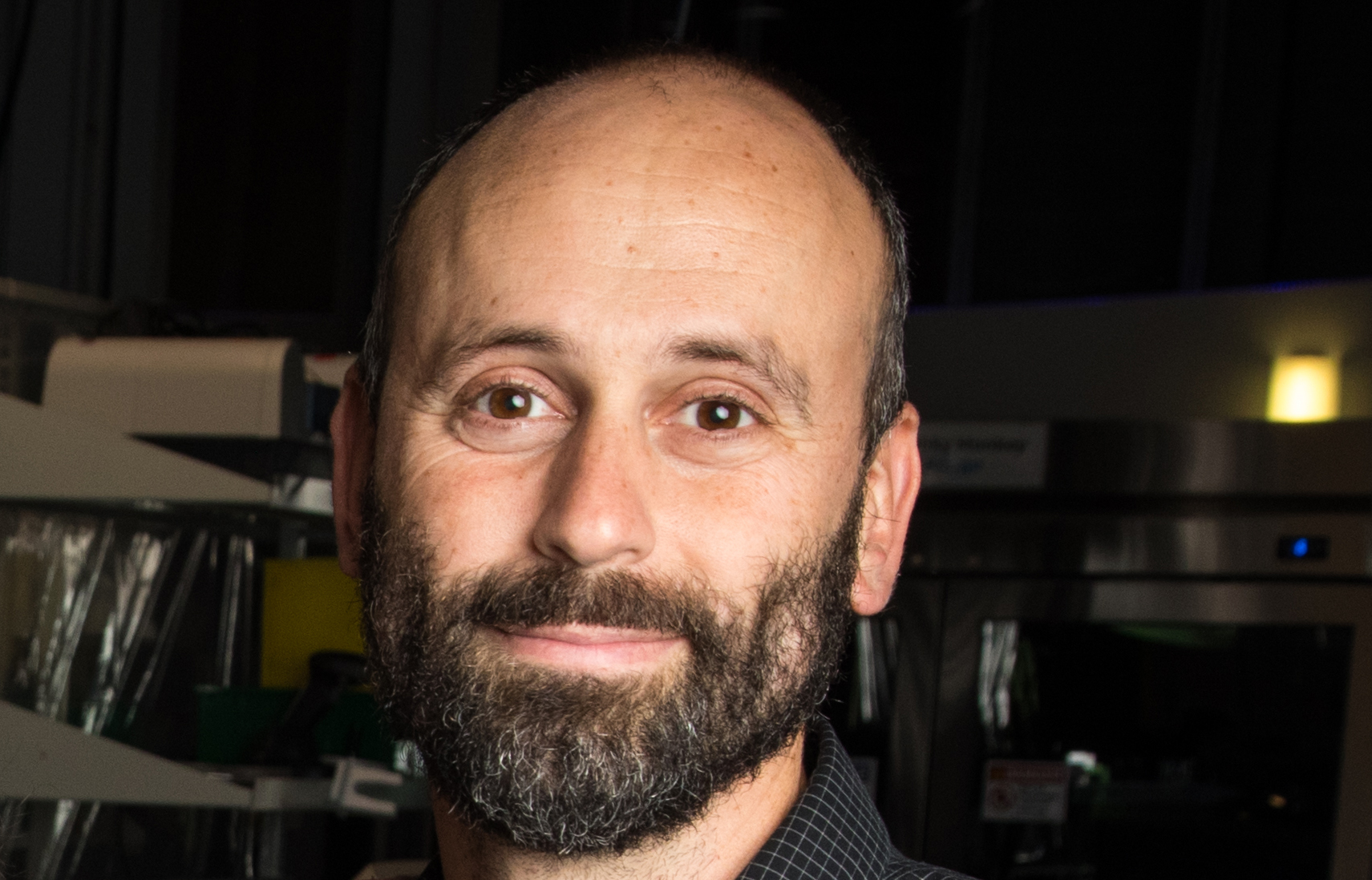
In terms of how the platform achieves such results, Manchester details: “At the core of our technology we have miniaturized the test tube down to roughly the width of a human hair and we run these ‘test tubes’ through a microfluidic chip at a speed of thousands of tests per second. Our throughput allows us to quickly sample the entire genome. The current state-of-the-art for high-throughput screening is liquid handling robots, which are bulky, expensive and orders of magnitude lower throughput than our platform.”
Giving an indication of speed, Manchester says that the Triplebar platform can screen one million samples in an afternoon on a chip that fits inside the palm of your hand. “By comparison, the largest and most sophisticated labs that have dozens of liquid handling robots screen the low end of thousands of samples per day. By quickly oversampling the genome we can find incredibly rare events that are tied to the phenotypic outcomes we care about, such as those impacting a techno-economic model,” he explains.
Growth strategy
How do such impressive-sounding stats actually accelerate the development of cultivated meat products? “Unit economics is the most critical prerequisite for the food industry,” believes Manchester. “In cultivated meat any cell line being used for full-scale commercialization will need to have specific phenotypic outcomes, such as the ability to grow quickly with high yield for manufacturing throughput. It will also need to grow on low-cost, serum-free media. These are two examples of the cell line phenotypes that our platform has the potential to impact.”
With regard to specific examples, Manchester describes recent proof points that include taking a cell line from isolation to suspension adaptation in roughly four months. He adds: “We also recently worked on a cell line where we were able to use our platform to double the viable cell volume. We’ve even been able to evolve cell lines that can grow without growth factors. We’ve successfully demonstrated that the platform works for multiple phenotypes across species, which is really exciting.” Manchester says that Triplebar wants to use its platform, behind the scenes with partners, to make commercial-scale cultivated meat possible and, he notes, “The best way to do this is by harnessing the natural algorithm for biological design, which is evolution.”
We offer an enabling technology that will accelerate product development timelines
This approach ties in with Manchester’s belief that specialization is key to success in commercializing cultivated meat. “We’re focused upstream in the value chain, and we partner with organizations that have expertise in manufacturing, sales, distribution and other later stage activities to commercialize products,” he explains. “We also work in precision fermentation for bioactive proteins so it’s important to us that we stay focused on using our resources in the space where we add the most value.”
When asked to comment on the current state of the industry, Manchester agrees that cultivated meat has certainly had some ups and downs, but he believes that for now, the focus must be on momentum. “Technical progress, repeatable data points and a path to commercialization are the best drivers of funding opportunities and/or meaningful commercial partnerships. Surviving this market in a way that doesn’t slow technical progress is key, and ecosystem partnerships are a great way to do that,” he says.
Manchester also mentions that what concerns him most when he looks at the bigger picture for humanity is the food system status quo and the massive negative impacts it has on our planet. “I’m glad to see that some governments and organizations are taking a leadership role as this becomes clearer to them,” he comments. “We need a robust ecosystem of many possible solutions to feeding the world’s population by 2050, and that means governments need to lead the way as well in supporting these efforts.”
If you have any questions or would like to get in touch with us, please email info@futureofproteinproduction.com







